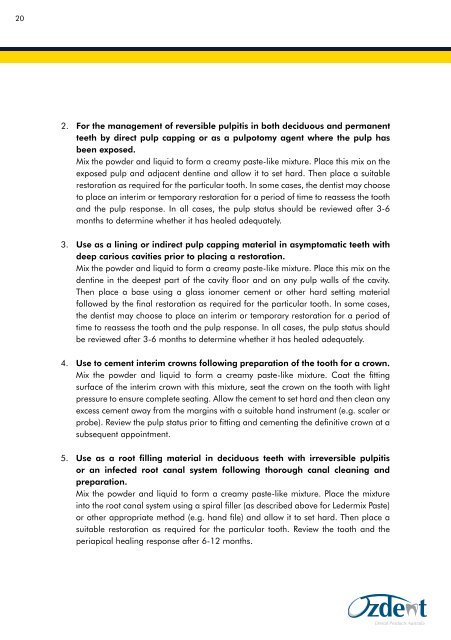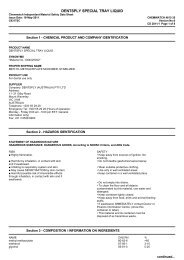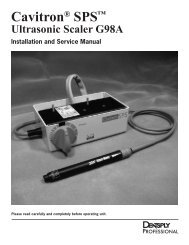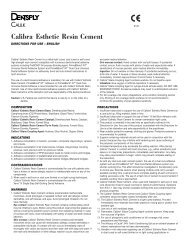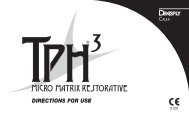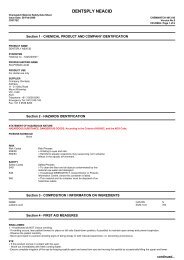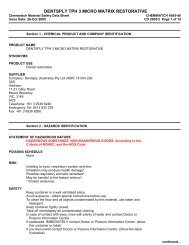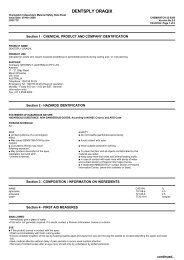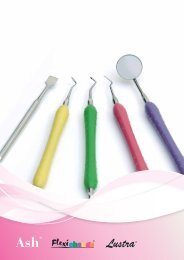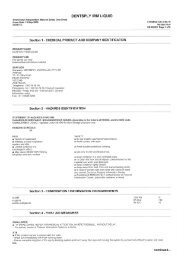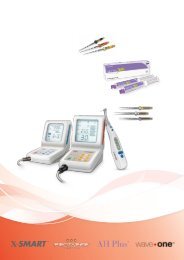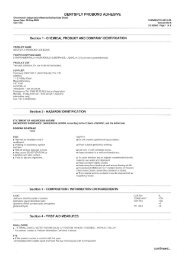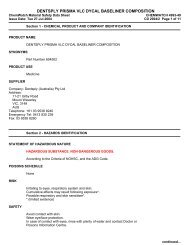The Materials - Dentsply
The Materials - Dentsply
The Materials - Dentsply
You also want an ePaper? Increase the reach of your titles
YUMPU automatically turns print PDFs into web optimized ePapers that Google loves.
20 21<br />
<strong>The</strong><br />
<strong>Materials</strong><br />
2. For the management of reversible pulpitis in both deciduous and permanent<br />
teeth by direct pulp capping or as a pulpotomy agent where the pulp has<br />
been exposed.<br />
Mix the powder and liquid to form a creamy paste-like mixture. Place this mix on the<br />
exposed pulp and adjacent dentine and allow it to set hard. <strong>The</strong>n place a suitable<br />
restoration as required for the particular tooth. In some cases, the dentist may choose<br />
to place an interim or temporary restoration for a period of time to reassess the tooth<br />
and the pulp response. In all cases, the pulp status should be reviewed after 3-6<br />
months to determine whether it has healed adequately.<br />
3. Use as a lining or indirect pulp capping material in asymptomatic teeth with<br />
deep carious cavities prior to placing a restoration.<br />
Mix the powder and liquid to form a creamy paste-like mixture. Place this mix on the<br />
dentine in the deepest part of the cavity floor and on any pulp walls of the cavity.<br />
<strong>The</strong>n place a base using a glass ionomer cement or other hard setting material<br />
followed by the final restoration as required for the particular tooth. In some cases,<br />
the dentist may choose to place an interim or temporary restoration for a period of<br />
time to reassess the tooth and the pulp response. In all cases, the pulp status should<br />
be reviewed after 3-6 months to determine whether it has healed adequately.<br />
4. Use to cement interim crowns following preparation of the tooth for a crown.<br />
Mix the powder and liquid to form a creamy paste-like mixture. Coat the fitting<br />
surface of the interim crown with this mixture, seat the crown on the tooth with light<br />
pressure to ensure complete seating. Allow the cement to set hard and then clean any<br />
excess cement away from the margins with a suitable hand instrument (e.g. scaler or<br />
probe). Review the pulp status prior to fitting and cementing the definitive crown at a<br />
subsequent appointment.<br />
5. Use as a root filling material in deciduous teeth with irreversible pulpitis<br />
or an infected root canal system following thorough canal cleaning and<br />
preparation.<br />
Mix the powder and liquid to form a creamy paste-like mixture. Place the mixture<br />
into the root canal system using a spiral filler (as described above for Ledermix Paste)<br />
or other appropriate method (e.g. hand file) and allow it to set hard. <strong>The</strong>n place a<br />
suitable restoration as required for the particular tooth. Review the tooth and the<br />
periapical healing response after 6-12 months.<br />
References<br />
1. Abbott PV, Yu C. A clinical classification of the status of the pulp and the root canal system.<br />
Aust Dent J 2007;52(Suppl 1):S17-S31.<br />
2. Abbott PV. Classification, Diagnosis and Clinical Manifestations of Apical Periodontitis. Endo<br />
Topics 2004;8:36-54.<br />
3. Abbott PV. Assessing restored teeth with pulp and periapical diseases for the presence of cracks,<br />
caries and marginal breakdown. Aust Dent J 2004;49:33-9.<br />
4. <strong>The</strong>rapeutic Guidelines: Oral and Dental. <strong>The</strong>rapeutic Guidelines Ltd. North Melbourne,<br />
Australia, Version 1, 2007.<br />
5. Abbott PV. Medicaments: Aids to success in Endodontics. Part 2. Clinical recommendations. Aust<br />
Dent J 1990;35:491-6.<br />
6. Heithersay GS, Hume WR, Abbott PV. Conventional root canal therapy, II: Intracanal medication.<br />
IN: Harty FJ, Ed. Endodontics in Clinical Practice 3rd Edition. Dental Practitioner Handbook No.<br />
24, Wright Butterworth Scientific, London 1990;162-85.<br />
7. Ehrmann EH, Messer HH, Adams GG. <strong>The</strong> relationship of intracanal medicaments to postoperative<br />
pain in endodontics. Int Endo J 2003;36:868-875.<br />
8. Negm MM. Intracanal use of a corticosteroid-antibiotic compound for the management of posttreatment<br />
endodontic pain. Oral Surg Oral Med Oral Pathol Oral Radiol Endod 2001;4:435-<br />
439.<br />
9. Abbott PV. Medicaments: Aids to success in Endodontics. Part 1. A review of the literature. Aust<br />
Dent J 1990;35:438-48.<br />
10. Pierce AM, Lindskog S. <strong>The</strong> effect of an antibiotic/corticosteroid paste on inflammatory root<br />
resorption in vivo. Oral Surg Oral Med Oral Pathol 1987;64:216-20.<br />
11. Pierce AM, Heithersay GS, Lindskog S. Evidence for direct inhibition of dentinoclasts by a<br />
corticosteroid/antibiotic paste. Endod Dent Traumatol 1988;4:44-5.<br />
12. Schroeder A. Cortisone in dental surgery. Int Dent J 1962;12:356-73.<br />
13. Schroeder A. Zur frage der konservativen und chirurgischen behandlung der pulpitis.<br />
Österreichische Zeitschrift für Stomatologie 1962;59:81-7.<br />
14. Schroeder A. Der gerbrauch von kortisonderivaten in der endodontie. Schweiz Monatschr Zahn<br />
1963;73:825-9.<br />
15. Schroeder A. Corticosteroids in endodontics. J Oral <strong>The</strong>rap Pharmacol 1965;2171-9.<br />
16. Hume WR, Kenney AE. Release of 3H-triamcinolone from Ledermix. J Endod 1981;7:509-14.


